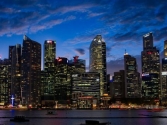
Commercial properties in AsiaPac to be robust in 2012
However, the risk of a slowdown is high in Singapore as rents have moved so quickly and have already reached their peak.
At a research event in Sydney, Jones Lang LaSalle’s Head of Research for Asia Pacific, Dr Jane Murray outlined a number of compelling high levels trends that would shape Asia Pacific property markets and drive growth forward:
Urbanisation and housing requirements – Each year an additional 30 million people are added to cities in Asia Pacific;
The changing wealth of the region means that by 2020, Asia Pacific will account for 50% of the world’s middle class (from its current level of 25%). This will increase to 66% in 2030, equating to 3.2 billion consumers;
4 countries in Asia Pacific will rank in the top 10 globally in terms of middle class consumption – China, India, Japan and Indonesia;
The growth in exports of commodities and manufactured goods is driving growth in the logistics sector, which will lead to increased take-up of industrial warehousing space; Already 8 out of the top 10 container ports in the world are based in Asia Pacific;
Increasing urbanisation is seeing Asia Pacific economies move up the value chain, with rapid expansion in the service sector;
Asia Pacific is producing 15 million new graduates a year, almost 3 times the number in the US and Western Europe;
This new workforce, including bankers and lawyers, will need offices to work in and as a result we are witnessing an explosion in office stock in Asia Pacific.
Dr Murray said, “The scale of population growth and urbanisation is enormous. If you assume an average of 30 square metres of residential space per person, then it is estimated Asia Pacific will need the equivalent of 45,000 Empire State Buildings over each of the next 10 years to house the additional people who will be living in cities.
“Over the last 20 years, the area of Grade A office space in Asia Pacific has increased from just 15 million square metres to 70 million square metres. The next 4 years alone will see an additional 35 million square metres of Grade A stock.
“At the same time, the region has seen strong take-up of space, particularly post the GFC. This year we are expecting a record level of net absorption, much of this attributable to the rapidly growing markets in China and India. Next year, the Asia Pacific economy should continue to outperform the rest of the world and grow by around 5.5% in aggregate, with many of the emerging economies likely to grow between 6 and 8%. In turn this is expected to drive continued take-up of space, although we are likely to see a moderation from the record levels of this year.
“We are currently forecasting further increases in rents and capital values of between 5%-10% in 2012 for most office markets in Asia Pacific,” said Dr Murray.
Market risks and opportunities for Asia Pacific in 2012:
Dr Murray cautioned that financial centres are still an area of concern in the region for a slowdown in 2012.
“The financial centres of Hong Kong and Singapore are more exposed to global trends and we expect a moderate slowdown in rents and capital values for both in 2012. Rents across the region have moved quickly from the downturn two years ago. Hong Kong and Singapore have moved so quickly that they have hit their peak already.
“At this stage we are forecasting that the world will manage to avoid a recession, in which case Asia Pacific should continue to outperform on the global stage.
“While growth in rents and capital values is forecast for most markets in the region, we expect the rate of growth to slow in some of the emerging markets including China and Indonesia in 2012 while in the Asia Pacific’s competitive advantage as an economic powerhouse will continue to drive the commercial property sector in 2012 advanced economies rents and capital values will continue to move ahead in Australia and should start to increase in Japan. This is a reversal of what we have seen to date in 2011.
“We saw a strong rebound in investment volumes in Japan in Q3 following a weak Q2 that was severely impacted by the March earthquake. Japan regained its top spot in the region with close to $5 billion of investment recorded in Q3. In 2012, markets such as Japan and Australia should be beneficiaries of investment capital looking for relatively stable returns.
“All of the forecasts for 2012 will be highly dependent on what happens in the global economy in the next few months. There is no doubt that the world is facing a more challenging environment as we head into 2012 but at this stage we remain optimistic about Asia Pacific’s outlook,” said Dr Murray.
























 Advertise
Advertise









